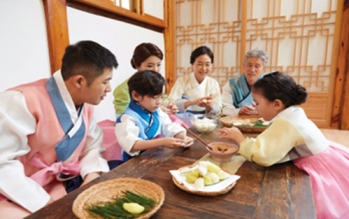Chuseok Special: Similarity between Korean fest Chuseok (추석) and Indian festivals
Chuseok, also known as the Korean Thanksgiving festival, is being celebrated today 29th September. In India also, September 29 marks the first day of a religious fortnight called Shraddh during which Indians remember ancestors and offer special food through priests.
With the coming of fall, festive spirits slowly start enveloping the air all around the world. Chuseok — the Korean Thanksgiving day, is one of the representative traditional Korean festivals celebrated in autumn on the full moon of the 15th day of the 8th month of the lunar calendar. Chuseok, also known as ‘Hangawi’ (한가위), is a mid-autumn harvest festival where families gather and celebrate a bountiful harvest while praying for the next harvest season to be better than the last.
This year Chuseok Day is being celebrated on September 29 but the holiday period actually lasts for three days in total – including the day before and after Chuseok. Traditionally, Koreans return to their ancestral hometowns to celebrate with it their families. On this day, a full harvest moon appeared in the sky and families gathered to enjoy time together and give thanks to their ancestors for the plentiful harvest. The women of the family also prepare an ancestral memorial ceremony called charye by filling a table with food including newly harvested rice and fruit.
Koreans celebrate Chuseok by making special foods, particularly a certain kind of rice cake called songpyeon. Songpyeon is made with finely ground new rice and the dough is kneaded into small round shapes and filled with sesame seeds, chestnuts, red beans, or other similar ingredients.
In India this year September 29 marks the first day of a 15-day long religious fortnight called Shraddh during which people remember their ancestors and offer them special food through Hindu priests. These days are regarded as the most sacred time of the year. Shraddh Paksha is another name for Pitru Paksha. Shraddh Paksha begins on Bhadrapada Purnima Tithi, which is today on September 29, in accordance with the Drik Panchang.
India is traditionally an agricultural land and a land of diverse culture, there are many harvest festivals, Holi, Bihu, Vaisakhi, and Pongal to name a few, that are celebrated in different parts of the country that resemble the Korean harvest festival, Chuseok.
 To celebrate Chuseok, the Korean Cultural Centre India in New Delhi hosted the event “Presenting Chuseok in India” on September 23, where participants experienced Korean Thanksgiving Day activities at the cultural centre auditorium. This event offered various programs, including a presentation about Chuseok and opportunities to engage in Korean traditional cultural experiences and food tasting.
To celebrate Chuseok, the Korean Cultural Centre India in New Delhi hosted the event “Presenting Chuseok in India” on September 23, where participants experienced Korean Thanksgiving Day activities at the cultural centre auditorium. This event offered various programs, including a presentation about Chuseok and opportunities to engage in Korean traditional cultural experiences and food tasting.
The program introduced the participants to Chuseok’s origins and the event itself. It offered activities such as “Korean arm wrestling”, “traditional Korean calligraphy”, using traditional Korean paper Hanji and a brush pen, and trying on traditional Korean clothing known as “Hanbok”. The participants also enjoyed the traditional Korean snack “songpyeon”, made by families on Chuseok, providing a moment to discuss their impressions of the event.
KOREAN FOOD:
Songpyeon:- The centerpiece of the ceremonial table of Chuseok, Songpyeon, the half-moon rice cakes, are a symbol of a good harvest. An old Korean anecdote says that a well-prepared songpyeon, in both shape and colour, leads to meeting a beautiful life partner and being blessed with a beautiful baby. While Pithas can be called the Indian equivalent of songpyeon, Gujiyas share similarities with it as well.
Hangwa:- Hangwa, another popular Korean traditional snack eaten during Chuseok refers to a general term categorizing sweet snacks made with rice cake characterized by natural colours, and textured patterns. The most popular types of hangwa are yakgwa, yugwa, and dasik. Imartis and jalebis look and taste a lot like Hangwa.
Sul (Korean Liquor) or K-Sool:- Another major element of Chuseok is Sul, the alcoholic drinks. Most commonly baekseju (white wine), a fermented alcoholic beverage made from Korean glutinous rice, is drunk on Chuseok. The liquor drunk on Chuseok is also called sindoju, which means new rice liquor as it is made of freshly harvested rice. Like Korea’s baekseju, Assam’s Judima is a popular rice wine made from sticky rice. Korean Soju and Makgeolli (rice wine) are available in India (online site, KS Foods)
DANCE & GAMES:
Ganggangsullae, an Intangible Cultural Heritage of Korea, designated by UNESCO, is a 5,000-year-old ancient traditional Korean dance. Traditionally, under the full moon night of Chuseok, this dance was performed by women of all ages to pray for a bountiful harvest. The steps of this dance is strikingly similar to many of the Indian folk dances performed during harvest season like Kummi of Tamil Nadu and Kerela, Bihu of Assam, Tarpa of Maharashtra, Karma of Jharkhand, etc.
Juldarigi, the Korean tug-of-war game, is played using an enormous hand-woven straw rope to bring about good fortune and a good harvest. It has become quite popular through the Korean drama series “Squid Game”. Korea’s Juldarigi has also been listed in UNESCO’s list of Intangible Cultural Heritage and enlisted as South Korean Intangible Cultural Property.
OTHER SIMILARITIES WITH INDIAN HARVEST FESTIVALS:
Holi, one of the major Hindu festivals, apart from its religious significance, is also a prayer for a good harvest season. Celebrations start on a full moon night, like Chuseok, and then continue the next day with people playing by splashing each other with powdered colours, and water balloons.
Bihu, a festival associated with agriculture and rice, and celebrated majorly in the state of Assam, is celebrated to enjoy a good harvest season with celebrations including dancing, singing, and eating special food, just like in Chuseok. Quite like gangangsullae, during Bihu, the women dance in circles to celebrate the abundant harvest.
Vaisakhi, also known as Baisakhi, is primarily a celebration of the spring harvest celebrated majorly in Northern India. Similar to Chuseok, this day is observed as a thanksgiving day by farmers whereby they thank God for the abundant harvest and pray for a bountiful harvest in the future as well.
Pongal is another one of the most popular harvest festivals celebrated mainly in South India’s Tamil Nadu by showing gratitude to nature. Sweets made from freshly harvested rice are prepared during Pongal just like songpyeons are prepared during Chuseok.
Festivities are an essential part of human culture and the lives of humans. Chuseok is a major harvest festival in Korea, and it is not surprising to see its similarities with so many Indian harvest festivals remembering Korea and India having shared a long-standing history. We, the Korean Cultural Centre India, wish all people in India to get the best harvest of the year with upcoming big festivals like Diwali through our Korean festival, Chuseok.

Major contribution: By Hwang Il-yong, Director of Korean Cultural Centre India (KCCI,) New Delhi.



